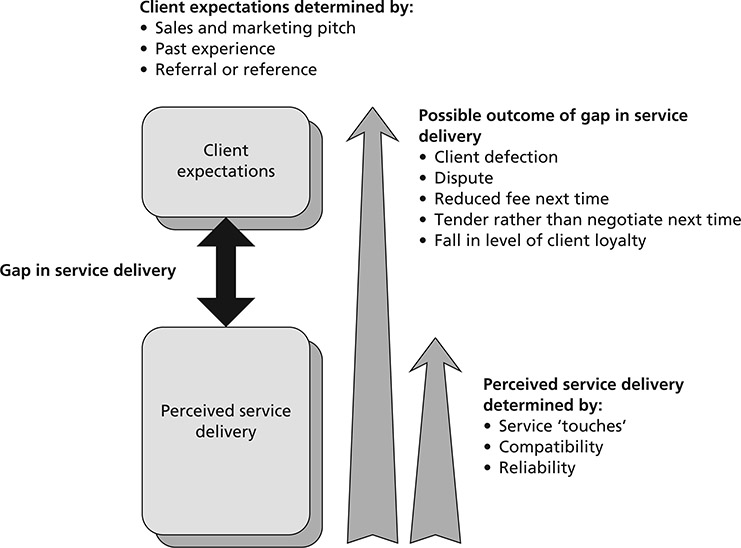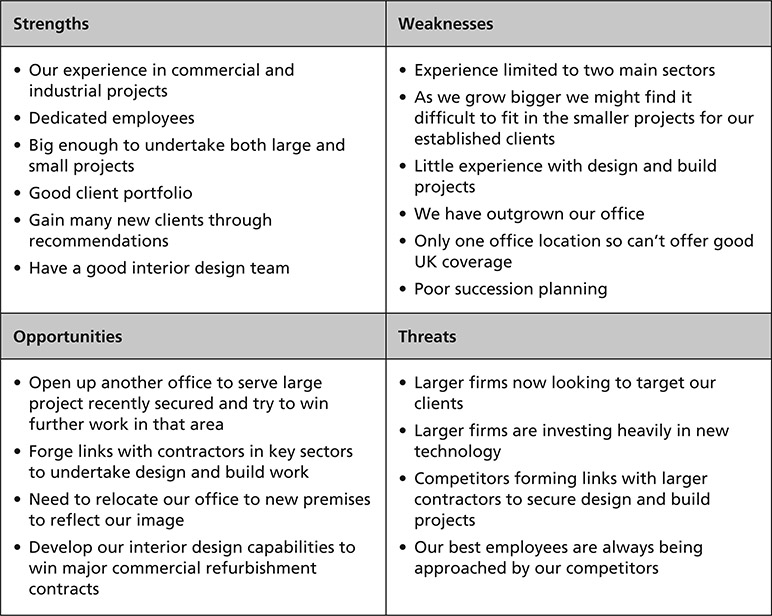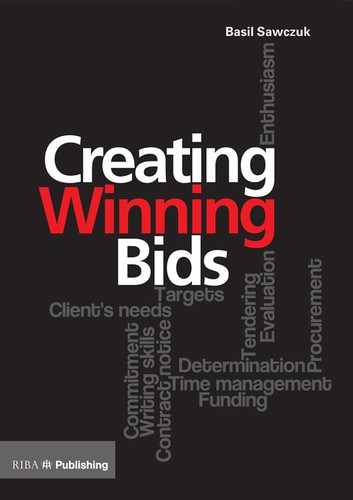Chapter 4
Improving your chances of success through better understanding of your competitors
Is there a favourite already?
When considering whether or not to bid for a tender, it is important to establish whether the potential client is communicating with some of your competitors. Alternatively, there may already be an incumbent consultant, in which case you need to ask yourself what are the realistic chances of succeeding.
Before committing valuable time and resources to a bid, you should look for signs to suggest that a tender has been put together to favour one of your competitors. Here are some indicators to look out for which could suggest that the client already has a favourite:
- There appears to be an emphasis on certain aspects within the evaluation criteria in which only an incumbent, or a favourite competitor, will be able to achieve top marks. An overemphasis on very specific experience might also indicate this bias.
- The evaluation criteria may have an unusual bias. If cost is normally evaluated at 60 per cent on this type of project and on this occasion it is only being evaluated at 10 per cent you ought to wonder why.
- A short deadline might favour a competitor who is already expecting the tender documentation and has some inside knowledge of the project. The competitor might have put the tender package together on behalf of the client or might have been involved in the briefing stage, helping the client to define their needs.
- A requirement for a fixed price when insufficient information is supplied.
- Documentation within the tender incorporates work from a competitor.
Sometimes projects are developed through a multi-stage process. The client might have appointed a team to prepare the briefing document to incorporate within the tender package. This team may then be free to bid for the work in the subsequent tender process. They would have a distinct advantage in that they have already built up a relationship with the client and are familiar with both the project and the needs of the client. In these situations it may be difficult to win the tender.
How to win if there is a favourite
If you think that there is a favourite or an incumbent then you need to make your bid stand out. There is no point in merely being the same or slightly better than the favourite if you want to win. If you have evaluated your chances of success and you still believe there is a chance to win, then you may decide to be bold and try:
- being categorically different
- telling them a story that they want to be part of. Forget all your traditional approaches – be in their face!
- checking whether there is an incumbent and, if so, how they have been providing the service. Present a solution which, in comparison to the incumbent’s, looks fresh and innovative, using current thinking and technology.
If there is an incumbent, focus on the service gap
Having undertaken your research and spoken with the client, you might have detected that the incumbent provider is not performing particularly well.
This could be for a number of reasons, such as:
- the incumbent has been paying more attention to winning new clients than to keeping current clients happy
- there have been delays, mistakes or poor quality work on current projects
- projects have been coming in over budget
- personality clashes may have arisen.
Alternatively, the incumbent might be delivering the promised service but, over time, the client has perceived that this service could be better. The client may have expected a continuous improvement in the service which hasn’t materialised. Sometimes the incumbent might actually be delivering a good service but simply not keeping the client informed of the benefits provided.
This situation can continue until the client detects, or perceives, a service gap developing, as illustrated in Figure 4.1.
If you detect that the client perceives the level of service being provided by the incumbent to be inadequate, then you need to emphasise your strengths. Initially, concentrate on your strengths in areas which match the incumbent’s weaknesses. So, if you are aware that projects have regularly come in over budget then show, giving examples, that your projects have kept within budget.

Figure 4.1: Service gap
As part of the ‘bid or no bid’ considerations you need to evaluate whether the perceived service gap that has developed is sufficient to cause a client defection from the incumbent. It may be that the client is simply testing the market to see if a switch to a new provider is of any benefit.
What to do if you are the incumbent
You may already be working for a client and you are aware that there will be other projects but the client, for various reasons, has to put them out to competitive tender. Alternatively, you may be unsure whether the client will go to tender. The client might negotiate with you or ask you for a proposal, after which, they may go to tender if not totally convinced by your offering. So, what do you do?
The key thing is to be alert to signs that may indicate your current relationship is weakening. Have you noticed any subtle changes in your relationship with the client? Perhaps there have been problems along the way and you are not sure what view the client has taken on these. The worst thing you can do is be complacent. Don’t just think you will win the next project because:
- the client knows and likes you
- you are the best, and your competitors don’t have a chance
- the client will not want to experience the cost, hassle and potential risk of changing consultants
- it is already ‘in the bag’.
Take time throughout your current project to meet the client and discuss your ongoing performance. Ask them for a ‘wish list’ of things they would like to do differently or add to the delivery performance. Possibly the best way of finding out what the client is really thinking is to schedule a neutral third party assessment (TPA).
The benefit of a TPA is that the client will find it easier to express opinions that they might not want to share with you directly. The TPA should be able to identify problems or issues that you were either not aware of or thought had been resolved. The exercise might provide further insights into your relationship with the client. It might, indeed, show that the client really does enjoy working with you. The very process of undertaking a TPA will show the client that you are actively engaged in ensuring their satisfaction. They will see that you are investing time, money and effort in your commitment to them. Also, what you may uncover and then address may improve your chances of winning the next bid. The feedback might help you to:
- improve your communications and performance
- counteract your competitors’ advances, as they may have been knocking on your client’s door
- generate ideas for innovation or mitigate trends that are pushing for change.
The best time to put a TPA in place is at least a year before your current contract ends. Better still, make a TPA part of your current contract schedule, beginning a few months after you have been awarded the contract and then recurring every six months or annually. What you must avoid is a sudden panic a few months before the contract ends and then starting to pitch for new work. The client will see through this. Better to show that you care from the outset. It takes so much effort to secure a good new client, so don’t jeopardise the chance to win more work through not being seen to want to improve or enhance your service delivery.
If you still find yourself having to bid for work when you are the incumbent, then take time to implement the following strategies:
- Find out who else, apart from your current client contacts, might be driving the new procurement process. Then, once identified, set about finding out what their priorities and preferences are.
- If you have been given a pre-qualification document to complete then don’t rely on your previous submission. What you are doing now may not be what the client wants in the future. Make your proposal look fresh, as if you are trying to win a new client. By all means remind them of all the good points of your current service provision. Also address any bad points so they are certain that your re-appointment will result in an enhanced service delivery.
- Answer the pre-qualification questionnaire properly and fully. Make your bid mirror what the documentation is asking for, not what you know ‘they really want or need’. Too many incumbents tend to price for things that are not specified and consequently price themselves out of a job. Equally, don’t tell the client that they are wrong or that they don’t really know what they want. Obviously, if you know of certain specific requirements which they have not included in their documents you can mention in your documentation that you are aware of these, as long as this will not cause them embarrassment. For example, you might be aware that the client’s employees are anxious about the new project, in which case you can emphasise how much effort you put into liaising with stakeholders to get them on board.
- Bid to win. Don’t be complacent. You might even bring in outside help to prepare your bid in order to bring a fresh perspective to your established approach.
Compare yourself to the competition
When putting together a strategy for bidding for more work you may gain some insight into what to pursue and your chances of success by considering the tactics of your competitors.
- In what sectors do they compete? Do they specialise in one or two sectors?
- What size of contracts do they undertake?
- Are they more successful than you and, if so, why?
- What client portfolio do they have? Can you learn anything from how they operate to win bids?
- Have you lost to them before? If so, have you obtained client feedback?
By doing this research you will be able to undertake a competitor analysis similar to the one illustrated in Figure 4.2.
By undertaking a competitor analysis you will be better placed to consider your likely chances of success and this will influence your ‘bid or no bid’ decision. This would be especially true if you are bidding for work in a small geographical area and particularly on smaller work which would not attract the interest of competitors outside the area. On larger projects, or in an another area, you may not be aware of who the actual competitors will be.

Figure 4.2: Competitor analysis
On some projects, especially public sector ones, there may be an open invitation for interested parties to attend a briefing session. By going along to these you may be able to identify some of the competitors who are showing an interest. You will also be able to see what the likely overall interest is going to be and evaluate your chances of success accordingly.
As part of your analysis, undertake a SWOT analysis. This is where you take a hard look at your firm and identify what you believe are your strengths, weaknesses, opportunities and threats. Do this on a project-by-project basis. An example is shown in Figure 4.3. If you have detected a specific weakness early enough, see if you are able to address it. However, if your competition is far more experienced in the type of building being tendered for and this aspect is heavily weighted in the scoring, then consider whether it is really worth pursuing the tender.

Figure 4.3: An example of a SWOT analysis
Differentiate yourself from your competitors to increase your chances of success
Your competitors may be communicating with your target clients on a regular basis so there is a need to differentiate yourself. You must stand out from your competitors in some way. This might prove difficult but submitting a thoroughly bespoke document that addresses the client’s specific needs will be a good first step and will greatly improve your chances.
In undertaking the competitor and SWOT analysis, try to identify anything you do that can help to set you apart. This could be your approach to a project, your experience or skill sets. Also, if you are able to identify specific benefits to the client from the service you are offering this would be an additional advantage.
It is very difficult to differentiate on price. If your message is that you are cheaper than your competitors then you may undermine your aim to be different. Of course, you may be cheaper or, shall we say, better value compared to competitors because:
- you are a multi-professional firm and so are able to provide all the required consultancy input and reduce overheads for the client’s benefit
- you are expert in the client’s sector and so have no need to go through a learning phase
- you have invested heavily in technology, which enables you to complete tasks more quickly and efficiently, thus offering the client savings
- you are local, thus saving on travel time when visiting the client and the site.
The other key point is to find what attributes the client prefers in their consultant. You might have identified these in your pre-tender discussions with the client. If you can identify these special attributes then present a key one, or several similar attributes, and try to differentiate yourself within your bid.
Should you discover, for example, that the client is extremely risk averse, you could address that in your bid by bringing out how:
- you have a specialist risk-avoidance champion
- you produce and regularly review a risk register on a wide variety of topics
- you hold workshops with the clients and other members of the team during the design and construction stages to make sure that the project is, and remains, within budget
- you take stakeholder management seriously and ensure that all the key people are on board with the project
- you have a strong commitment to in-house quality assurance procedures
- you invest in training to keep up to date in all aspects of risk management.
The key to effective differentiation is not to be all things to all people. You will need to change your bid documents to suit your specific target client. The skill lies in making the client believe you are a perfect fit and that you share the same values.
When you submit your bid, highlight the three key areas that go to the heart of addressing the client’s needs. You are then well on the way to differentiating yourself and tailoring your bid to the client’s needs. During the briefing stage, why not ask your client to pick out the three most important issues. Talk around each issue and see how you can shape your service correspondingly.
If you then need to expand each of the three points, try to find three ways to describe the benefits to the client. The power of three is a forceful tool.
Differentiate through customer service
The ideal situation is to acquire a level of competitive advantage that is sustainable over time and allows the client to perceive benefits during that time.
If you are able to differentiate yourself and appear to offer greater benefits than your competitors, other than price, then you will be able to:
- command a premium price for your service
- achieve better client loyalty
- win more work.
So, how can you improve your level of customer service so that it becomes a differentiating factor? Well, some of the areas you could tackle are:
- changing your culture so that it is client driven
- investing in good people – professional service firms ‘sell’ people, so your people need to be better than your competitors’
- investing in training – find out where there are weaknesses and train your people to excel
- promoting a positive culture
- appointing a client service champion
- trying to integrate the client into your organisation and teams
- delivering your promises
- striving to be the best.
Maximising your strengths and subtly revealing the weaknesses in your competition
During your competitor analysis you may uncover a particular strength you have when compared to your competitors. Or, alternatively, you may be able to positively differentiate yourself from various competitors in different ways. You can use this to your advantage.
You should never criticise your competitors but you can highlight their weaknesses by making a point of showcasing your strengths.
For example, one competitor may have a particular strength in the market sector being tendered. However, they are not local, so you could make a point of emphasising in your proposal the benefits to the client of having local knowledge.
▸ Summary Checklist
- Look out for signs that there is already a favourite consultant
- If there is a favourite, consider whether it is worth competing
- If competing when there is a favourite, then strive to differentiate yourself. Be categorically different
- If there is an incumbent consultant, investigate to see if there is a service gap. In your proposal, emphasise your strengths, which might just be the incumbent’s weaknesses
- If you are the incumbent you will need to make a real effort to make your proposal look fresh. Don’t be complacent and consider that the same service delivery will be satisfactory
- Consider a third party assessment to establish what the client really thinks about your service delivery
- Undertake a competitor and SWOT analysis
- Spend time on differentiating yourself from the competition
